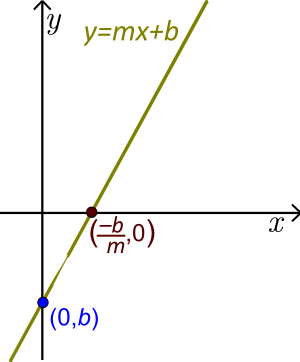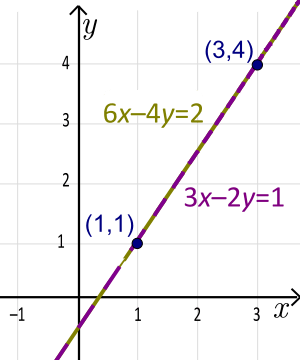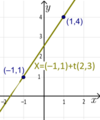Linear function facts for kids
In math, a linear function is a special kind of rule. When you draw its graph, it always makes a straight line. For example, the rule y = 2x - 1 is a linear function. If you pick numbers for x and find y, then plot those points, they will all form a straight line.
Contents
What is a Linear Function?
A linear function takes a number as input and gives you another number as output.
- You put a real number (let's call it x) into the function. This x is the input.
- The function then gives you a real number (let's call it y) as the output.
- When you plot all these pairs of numbers (x,y) on a graph, they always make a straight line.
There are three main ways to write linear functions: slope-intercept form, standard form, and parametric form.
Slope-Intercept Form
The slope-intercept form is a common way to write a linear function. It looks like this: 
In this form:
- x and y are variables.
- x is the independent variable. You can choose any real number for x.
- y is the dependent variable. Its value depends on what you chose for x.
- m and b are constants. They are specific numbers for each line.
- m is the slope of the line. It tells you how steep the line is and which way it goes (up or down).
- b is the y-intercept. This is the point where the line crosses the y-axis. It's always the point (0, b).
Understanding Slope (m)
The slope m tells you two things about the line:
- Direction:
- If m is a positive number (like 2 or 5), the line goes up as you move from left to right.
- If m is a negative number (like -2 or -5), the line goes down as you move from left to right.
- Steepness:
- If the number m (ignoring its sign) is small (like 0.5), the line is gentle.
- If the number m (ignoring its sign) is large (like 5 or -5), the line is steep.
For example, in y = -2x + 4:
- The slope m is -2. This means the line goes down.
- The y-intercept b is 4. So the line crosses the y-axis at (0,4).
- Since the slope is -2, for every 1 step you move to the right on the graph, the line goes down 2 steps.
Horizontal and Vertical Lines
- Horizontal lines are included in linear functions. If m = 0, the equation becomes y = b. This means y is always the same number, no matter what x is. This makes a flat, horizontal line.
- Vertical lines are NOT linear functions. A vertical line has an equation like x = b. It doesn't pass the "vertical line test" (meaning one x value has many y values), so it's not a function.
Graphing a Linear Function
To draw a linear function, you only need two points. 1. Pick two different numbers for x. 2. Use the function rule to find the y value for each x. 3. Plot these two (x,y) points on your graph. 4. Draw a straight line through these two points, extending it in both directions.
Example: Let's graph y = -2x + 4.
- If x = 0, then y = -2(0) + 4 = 4. So, one point is (0,4). (This is the y-intercept!)
- If x = 1, then y = -2(1) + 4 = 2. So, another point is (1,2).
- Plot (0,4) and (1,2) and draw a line through them.
Standard Form
Another way to write a linear function is the standard form:  In this form:
In this form:
- x and y are the variables.
- A, B, and C are constants (numbers).
- Important: B cannot be zero. If B were zero, you'd have Ax = C, which is a vertical line (and not a function).
Example: The equation 3x - 2y = 1 is in standard form. Here, A = 3, B = -2, and C = 1.
Sometimes, you might see this form written as  . For example, 3x - 2y - 1 = 0 is the same as 3x - 2y = 1.
. For example, 3x - 2y - 1 = 0 is the same as 3x - 2y = 1.
One thing to know about standard form is that the numbers A, B, and C are not unique. You can multiply all three by the same number, and it will still be the same line. Example: The lines 3x - 2y = 1 and 6x - 4y = 2 are actually the same line! We just multiplied the first equation by 2 to get the second one. If you solve both for y, you'll get y = 1.5x - 0.5.
Linear Function vs. Linear Equation
People sometimes get "linear function" and "linear equation" mixed up.
- A linear equation means that all the variables in it have a power of 1 (like x or y, not x² or y³). A linear equation can have one, two, three, or even more variables.
- A linear function is a special type of linear equation that has exactly two variables (usually x and y), and its graph is a straight line.
* A linear equation with one variable (like x = 5) is just a single point on a number line. * A linear equation with three variables (like x + y + z = 10) makes a flat surface called a plane in 3D space.
Different Ways to Write It
Different countries and subjects might use slightly different letters for linear functions:
- In many places, you'll see
 , where a is the slope and b is the y-intercept.
, where a is the slope and b is the y-intercept. - In business or economics, it's sometimes written as
 , where a is the y-intercept and b is the slope.
, where a is the y-intercept and b is the slope.
Images for kids
Related pages





